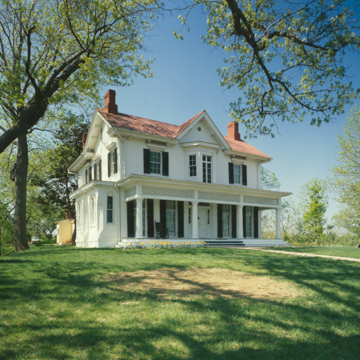You are here
Frederick Douglass National Historic Site
Frederick Douglass, African American abolitionist publisher, orator, author, statesman, and champion of human rights, purchased this house in 1877. He lived here until his death in 1895. The building served as a retreat with opportunities for gardening, but was not Douglass's principal residence. The house is significant both for its famous owner, but also because it demonstrates the positioning of a romantic cottage in natural surroundings. The National Park Service acquired the site in 1962 and it was added to the National Register of Historic Places in 1966.
Although modest in its scale and ornamentation, the Frederick Douglass House exhibits characteristics promulgated by Andrew Jackson Downing and his followers for a romantic cottage situated in natural surroundings. The gable intersecting the roof in the center bay of the main facade is an external expression of the cross-axial flow of interior space associated with Downing's picturesque principles for homey domestic architecture. The second-story bay window together with those added later on the ground story brought in more light at the same time that they provided wider views of the surrounding countryside. The porch traversing the entire front (an American invention) helps to break down the division between inside and outside space, while it provides a partially sheltered locale from which to enjoy prospects and fresh air. Floor-to-ceiling windows on the first floor, which are obscured by the porch, admit additional light and could be opened for cross ventilation. The front door with side lights harks back to earlier nineteenth-century styles. The overlay of classical details, the Doric porch columns and bay window pilasters, on what Downing proposed as a medieval revival form with cross gables, shows how each builder or owner interpreted the new style according to individual tastes and needs.
References
“Frederick Douglass National Historic Site.” DC Historic Sites. Accessed May 9, 2020. https://historicsites.dcpreservation.org/.
“Frederick Douglass National Historic Site Cultural Landscape.” National Park Service. Accessed May 9, 2020. https://www.nps.gov/.
Writing Credits
If SAH Archipedia has been useful to you, please consider supporting it.
SAH Archipedia tells the story of the United States through its buildings, landscapes, and cities. This freely available resource empowers the public with authoritative knowledge that deepens their understanding and appreciation of the built environment. But the Society of Architectural Historians, which created SAH Archipedia with University of Virginia Press, needs your support to maintain the high-caliber research, writing, photography, cartography, editing, design, and programming that make SAH Archipedia a trusted online resource available to all who value the history of place, heritage tourism, and learning.














